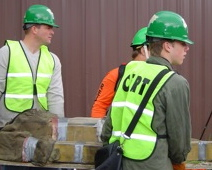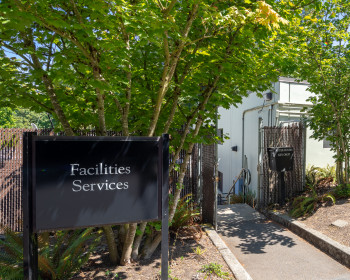Five new tactics help ensure campus safety
Open gallery

As always, the folks in Campus Safety are continuing to refine and rework their methods of addressing safety issues on campus quickly and efficiently. The Source caught up with Campus Safety Director Tim O’Dwyer and Campus Safety Supervisor Mark Nisbett to learn more about five recently implemented strategies:
1. An upcoming tabletop exercise to improve procedures for major campus events.
By law, the college must have some kind of emergency drill on a yearly basis. In years past we have had simultaneous drills on all three campuses, requiring all community members to be involved in specific actions, such as building evacuation, duck/cover/hold, or building lockdowns. As valuable as those exercises are, we decided this year to concentrate on major disaster response planning.
On March 21, we will meet with community members who play some role in managing major events—such as commencement and large concerts. Our thought is that they would be our first responders in the event of a disaster. The idea of this drill will be to work through the necessary steps to respond and react to a disaster with the people and resources we have on hand, transitioning to different roles as necessary. This emergency response exercise will help improve planning for:
- Evacuations
- Search and rescue
- Medical treatment
- Establishing an Incident Command System (ICS) structure
- Clear communication with the L&C community, Community Emergency Response Training (CERT) team members, and emergency responders
Additionally, Campus Safety expects to identify some areas where the college needs to spend more resources or commit to more training.
2. Lewis & Clark is now host to an emergency ham radio and operator.
Officer Julie Couch is a ham radio operator, and she routinely drills with her Multnomah County counterparts, testing the readiness of our regional communications response. Thanks to Couch’s efforts, Lewis & Clark is a valuable resource to Multnomah County Emergency Managers.
This gives us the ability, when all other communication modes have failed, to communicate with local hospitals, fire departments, the Red Cross, and FEMA. It would also allow us, in that same circumstance, to communicate both internally and externally by using the ham radio to send emails. We are currently testing whether there are limitations as to groups and size.
3. Lewis & Clark now utilizes Incident Command System (ICS) procedure for emergencies on campus.
The basic premise of this approach is that there is one person in charge—known as the incident commander. All information flows up and down the structure, with persons supervising at most seven individuals. College titles are left at the door, and persons best suited to be managers of a specific incident make the decisions. A communications plan goes hand in hand with the ICS structure, so that all involved understand how to communicate in an emergency.
At Lewis & Clark, a command post would house the incident commander and the Incident Management Team. Their charge is scene stabilization. For a disaster affecting the college long term, we would also use an Emergency Operations Center, where the college’s Crisis Management Group would manage the impact on the institution as well as coordinate on-scene activities for the incident commander.
4. Free Community Emergency Response Training (CERT) courses for faculty and staff.
A CERT course will take place in June. Typically CERT courses are held every Tuesday for four weeks, culminating with a half-day field exercise. The course covers emergency medical, triage, incident command structure, search and rescue, and emergency preparedness. CERT is part of FEMA’s Citizen Corps and was developed to help citizens help themselves before, during, and after disaster strikes. Every year, self-activated citizens respond to emergencies. Unfortunately, too often the rescuer can become the victim as well. CERT courses give people the training and tools to help themselves and help others safely.
5. Earthquake preparedness (April is Earthquake Preparedness Month).
We want people to ask themselves, “What if?” If a major earthquake hit, and there was no running water, no electricity, and phone lines were down, how would I get food and water? How would I contact my family? How would I get home? We would like people to consider having a 72-hour supply of food and water at their work place and in their cars. The time to consider these things is now and not when the event happens. Please take the time to review information offered by the following resources:
- American Red Cross
- Federal Emergency Management Agency (FEMA)
- Citizen Corps
- Portland Emergency Management
- Lewis & Clark Campus Safety
More The Source Stories
email source@lclark.edu

